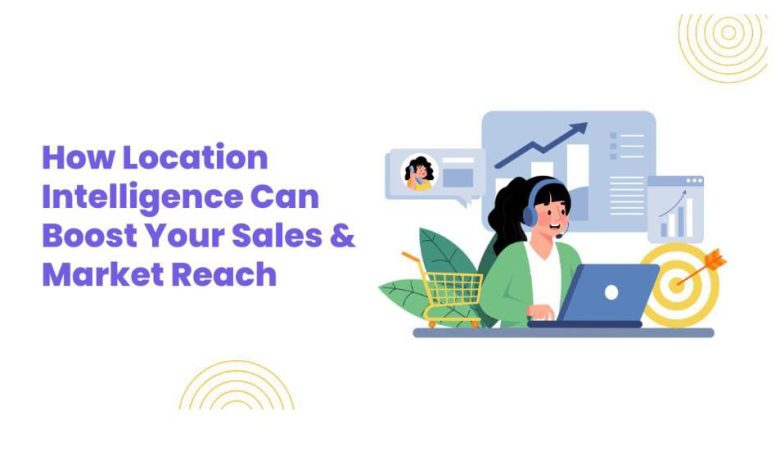
Location is more than an address on a business card. Today, it’s a strategic asset. Location intelligence (LI), which analyzes geospatial data to unearth patterns, trends, and relationships, helps companies discover where customers are, how they behave, and where opportunities reside. Used correctly, location intelligence turns gut-feel marketing into targeted expansion, better retail placement, more innovative logistics, and measurable revenue lifts. In this blog, we’ll take a look at location intelligence, what it is, why it’s essential, and, importantly, how you use it to move the sales needle and expand market reach, with practical tips, tools, KPIs, and common pitfalls.
What is Location Intelligence?
Location intelligence encompasses geographic data (where things are) and analytical tools that, when applied to the data, produce actionable insights. Sources of location data include:
- Customer addresses and delivery locations
- Signals from mobile and apps (with consent)
- Point of sale and transaction locations
- Social media check-ins and geotagged posts
- Public data: census, demographic, traffic, zoning
- Business locations: stores of competition, partners, suppliers
- IoT and sensor data (footfall in store, beacons, sensors)
Tools and techniques map and analyse this data to answer questions like: where are our best customers concentrated? Which new neighbourhoods match our target persona?
Why Does Location Intelligence Matter For Sales & Market Reach?
- It aligns resources with reality. Rather than using broad strategies, you can take the time to focus on the neighborhoods, channels, and times that deliver results.
- It reveals new potential customer segments by geography. Some markets are evident; others are hidden micro–markets that offer tremendous purchasing potential.
- It improves targeting and personalization. The marketing and sales teams know where the customer lives and which stores he shops at, and they can send hyper–relevant messages.
- It optimizes the offline presence. Store placement, pop–ups, distribution centers, etc., can all be enhanced through geospatial analysis.
- It reduces the cost and increases speed. Better routing, more intelligent ad spend allocation, and higher conversion rates all enable you to drive more sales with less expenditure.
What Are The Concrete Ways Location Intelligence Boosts Sales?
1) Putting the Store Closest to the Field of Sale
Apply demographic overlays based on competitor locations and foot traffic to generate storefronts or franchises, including income, household size, and age of the target group.
For example, placing two small-format stores in a group of underserved high-affinity microzones, rather than one large flagship format store, would yield the highest combined revenue per square foot.
2) Intelligent Geographic Market Expansion (Next Place of Expansion)
Rate new or potential markets in terms of their composite scores from the following criteria: market size, local demand, competitive pressure, shipping costs, and cultural fit. It prevents costly trial-and-error-type expansion.
3) Geo-Targeted Marketing and Promotions
Supply local specials (i.e., lunchtime discounts for office clusters or family bundles on weekends near suburban parks). Because location-specific advertising is contextually relevant, click-to-conversion rates are typically higher.
4) Territory Design and Sales Routing
Maximise sales rep territories to reduce workload and improve coverage. Improved route planning, due to traffic and appointment density, saves fuel and time while increasing face-to-face selling time.
5) Competitive Intelligence and Benchmarking
Map competitor locations and performance to identify operational gaps within a 2-kilometre radius with no direct competition but a strong demographic fit. Conversely, use LI to find those areas involved in saturation.
6) Demand Forecasting And Inventory Allocation
Forecast local demand by utilising historical sales data + local events, seasonal foot traffic. Move inventory to the most-needed outlets to eliminate stockouts and lost sales.
7) Local SEO and Online to Offline Attribution
Optimise Google My Business site listings, local keywords, and geo-targeted ads. Compare online location data collection results with in-store point-of-sale data to account for digital spend in offline conversions.
8) Experiments and Micro tests
Run a geo-fenced promotion campaign in a small area to test product-market fit before rolling out to mass consumption. If the required Key Performance Indicator (KPI) is achieved, the website should be scaled up.
How To Implement Location Intelligence (Step-By-Step)?
Stage 1: Specify the correct data
Begin with what exists and build incrementally on
- Customer locations and order locations (CRM, e-commerce).
- Transactional data (time, SKU, amount).
- Shop or leisure locations, times of doing business.
- Public data (census, transport, zoning).
- Optional: application-based geographic information, footfall sensors, beacons.
Privacy check data confiscations, carrying out data based on behaviour-specific app usage.
Stage 2: Clean and standardise geodata
Geocode addresses to lat/long, standardise formats, and remove duplicates. Poor local geocoding leads to poor decisions based on fully geocoded data and indicates that the sample is not validated.
Stage 3: Business questions and KPIs
These must not be based on reasoning for the sake of reasoning.
- Which neighbourhood generates 60% of our income?
- Where is it best to locate the following three stores to maximise ROI
- Where is the best place to spend, delivering the best in-shop conversion
Related KPIs:- Revenue per sq ft, CaC by geography, incremental sales lift by geo campaign, and delivery cost per order.
Stage 4: Visualising and exploring
Synthesising sales, customer density, and competitors on a map. Heatmaps, choropleth maps, and clustering maps can reveal patterns.
Visualisation will reveal hypotheses very quickly. e.g., Area high in density, low in sales distribution and/or awareness poor.
Stage 5: build models and run analysis
Common LI Analysis –
- Hotspot analysis shows high-activity clusters.
- Drive-time and isochrone analysis: catchment areas shown within 5-, 10-, and 15-minute prompts.
- Site suitability scoring.
- Composite score indicator for site quality.
- Market potential scoring. It ranks markets based on demographic fit and penetration.
In spatial regression with spatial predictors, can you predict sales?
Stage 6: Act and test
Use Predictive techniques to target campaigns, Open pilot stores, or adjust delivery coverage based on insights as needed. A/B (by geography) will enable you to track the ROI of campaigns.
Stage 7: Measure, iterate, and scale
Monitoring KPIs refines models. Good LI is led. e.g., Models improve with new information and feedback loops from data and inputs.
What Kpis Measures Location Intelligence’s Impact On Sales?
Track both leading & lagging metrics.
Leading Metric
- Footfall and visits to the area under evaluation
- Click-through and conversion rate of geomarketing ads
- Increased awareness metrics in store (local surveys)
Lagging Metric
- Growth in revenue in the targeted areas
- Incremental sales lift vs. controlled geographies (A/B geo tests your own)
CAC by geography
- In-store visit conversion rate coming from local campaigns
- Reduction in delivery/routing cost per order
The goal is to run a geo A/B test to isolate the impact of LI-driven changes.
What Are The Best Practices and Tips of Location Intelligence to Boost Sales?
- Start Small, Prove Value: One campaign in one metro area. Runs in test markets with control areas to measure lift.
- Respect Privacy: Always secure consent for mobile/app location data. Aggregate and anonymize when possible
- Combine Spatial with Behavioral: Location is seldom sufficient in itself. Combine with purchase history, recency, and product affinity.
- Use Real World Tests: Test geo-fencing and pop-up experiments. Yield faster feedback than long-term rollouts.
- Keep Data Fresh: Neighborhoods change rapidly. Refresh data quarterly or at least more often than required for footfall/real-time signals.
- Operationalize Insights: Translate insights into playbooks for marketing, operations, and sales, not just reports.
- Train Cross-Functional Teams: Geospatial Literacy for marketing, sales, ops, etc., enables faster adoption.
What Are The Common Pitfalls and How To Avoid Them?
Analytical pitfalls
Relative weight of a single source
If census data are used or mobile pings are employed, it is not possible to understand the context or background.
Remedy: Combine multiple data streams and validate against past outcomes.
Poor geocoding
Poor addresses will go to the wrong place.
Remedy: Validate samples and use robust geocoding systems, standardizing address inputs at collection.
Ignoring privacy
Employing individual location data without permission is legally irresponsible and damaging to the membership.
Remedy: Secure permission, use aggregated data, and consult legal.
Confusing correlation with causation
High sales in an area may be correlated with an unmeasured variable.
Remedy: Carry out controlled geo-experiments to establish causation.
Misjudging operational standards
Here, the insight says open, but the lease rentals or supply chain leave no room for it.
Remedy: Incorporate operational feasibility into the scoring models.
ROI: Making the Business Case
To sell LI, you need to tie it back to cold, hard dollars. Here’s one way to go about it:
- Estimate the opportunity: Pick a particular geography and estimate the untapped chance (i.e., no. of households x the conversion rate x average order value).
- Model the costs: include licensing, geocoding, personnel/consulting, and campaign/stores spending.
- Estimate the benefit: Incremental revenues from targeted campaigns, lower delivery costs, and saved spending on advertising by virtue of the targeting.
- Run scenarios: Show conservative, base, and aggressive assumptions to indicate sensitivity.
- Pilot proof: Have a small pilot, where you can predict measurable KPIs in 8-12 weeks.
A modest start for LI often yields quick wins (better CAC in target zones, increased conversion rates, etc.) and a clear roadmap for scaling.
What Are The Future Trends To Watch?
- Privacy-centric analytics: Aggregation, federated learning, and differential privacy—are changing how location data is used.
- Real-time foot traffic and sensor data: Stores are increasingly using live data (queues, crowd sizes) to trigger promotions and staffing assignments.
- Indoor mapping: Reliable indoor location (malls, airports) will facilitate hyperlocal offers and in-store personalization.
- AI-powered site selection: As machine-learning models improve at predicting lifetime value before opening, location-intelligence solutions are becoming more accurate, faster, and more privacy-conscious.
Conclusion
Location intelligence provides the bridge between what people do and how that shapes digital strategies. It sharpens targeting, eliminates unnecessary expenditure, and reveals previously hidden opportunities that traditional analytics can’t uncover. Whether you’re a local retailer, expanding quickly as a D2C brand, or running a national B2B sales arm, LI answers questions that are fundamental to success: where your best customers live, the optimum expenditure on marketing, and the best locations for real-world assets.
If you learn one thing: start with a defined pilot linked to an agreed KPI. Show that decisions based on location improve sales relative to a control, and that the budget and support for development will follow. It’s not just about geography — it’s about profitable insight.




